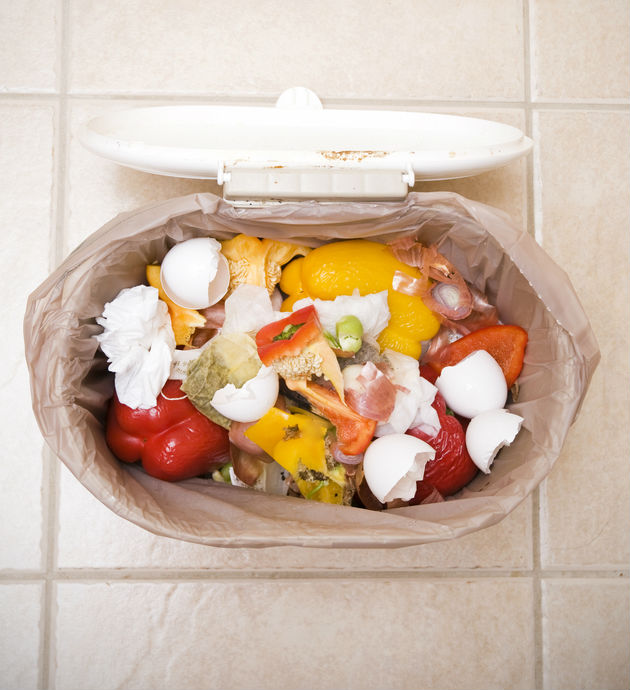Food scraps are inevitable, but they add up to a large amount of waste: uneaten food accounts for 20 to 30 percent of what put into the garbage, according to the EPA. You hate to just throw the scraps out, but it’s not like you can have a compost pile in your small apartment, right?
Not so fast! You might not have a full yard–whether you’re a 20-something in your first apartment or a senior living in a small space–but a compact compost bin under your sink will go a long way toward reducing the waste you produce. Your food scraps will stay out of the landfill and turn into rich fertilizer that your indoor garden will love.
Creating Your First Indoor Composting Bin
The most efficient method of composting indoors is with worm composting, also called vermicomposting. You’ll hardly notice it’s there — a properly maintained bin is odorless.
The first step to composting is to find the perfect container. There are many commercially available products that can fit under your sink. Look for ‘compost digesters’ or even better, ‘compost tumblers.’ Alternatively, you can make your own out of a heavy duty trash can. Simply drill 1.5 cm aeration holes evenly spaced around the lid of the can.
Next, you need the little recyclers who will do all of the hard work for you: worms. In particular, you need red wiggler worms (Eisenia foetida). These little guys eat half their weight in food each day! How many worms will you need? One pound of red wigglers will eat approximately 3.5 lbs. of food waste per week.
Now that you have all of the ingredients you need, you can create your first worm bin:
- Fill bin about two-thirds full with damp strips of paper.
- Add some dry leaves, and sprinkle garden topsoil on top to jumpstart the composting process.
- Add worms.
- Let the composting begin!
Feeding Your Wigglers
With your worm bin set up, you are ready to transform your leftovers into your wiggler’s next meal. But don’t go throwing everything in the bin willy-nilly! Your worms prefer a balanced diet, preferably vegetarian. Don’t feed them meat, bones, fish, grease and oils, or dairy products of any kind. These products imbalance your carefully constructed ecosystem and even worse, make your bin smell!
You’ll soon get the hang of what your worms like the best. Here are my tips for getting the most out of your compost:
- The key to a healthy compost bin is an even mix of green/wet and brown/dry ingredients.
- Don’t just dump your scraps on top. Keep a stash of shredded paper, cardboard, or dry leaves (brown ingredients) and add a handful each time you add more wet material.
- The bin should be moist but not soggy.
- Regularly mix the contents to introduce air and increase the rate of composting. If your bin doesn’t come with a mixer, use a shovel or hand trowel or roll the bucket back and forth.
- Worms particularly love egg shells (rinsed and crushed), tea bags, plant clippings, coffee grounds, rice and pasta, and fruits and vegetables.
- Watch out for citrus peels — too many can make the bin too acidic, harming your worms.
- Your worms need a variety of food sources — too much of one thing will slow down the compost process.
- Cut up big scraps — the smaller the pieces the faster they’ll break down.
- Freeze or microwave your scraps before placing in the bin to reduce fruit fly risk.
A properly-managed bin will not attract pests or smell bad. If your bin does start to smell, think about what you’ve put in it. If you notice certain items aren’t breaking down, rethink putting them in the bin. When your compost bin is balanced — green and brown, wet and dry, regularly mixed — your worms will do the hard work for you without any odors. If it weren’t for how empty your garbage can is, you might forget your compost bin is there!
Waste Turned Into Something New
Composting isn’t only for those with large yards. Just like your indoor garden can fit on your windowsill, your compost bin can fit under your sink. When your compost is ready, you will have a dark brown, spongy, soil-like mixture at the bottom of the bin. Rich in nutrients, it is a perfect fertilizer to help your plants thrive.
With a worm bin, you will decrease the amount you throw into the garbage and transform it from waste into a valuable resource. For the seniors I work with in my profession, composting and gardening go hand-in-hand, and it’s an excellent way to maintain a green thumb even after long days in the backyard garden are no longer physically feasible. But there’s no need to wait until you age to start a small indoor garden. Use your compost to nurture your veggies and herbs and the circle will be complete. Now that’s sustainable living!
Shayne Fitz-Coy is the Co-CEO and President of Alert-1, an aging-in-place technology company headquartered in Williamsport, Pennsylvania with offices nationwide. Shayne hails from Maryland, and now calls the Bay Area home.


Nick Lyons
Great post. I never knew that too much citrus could be a bad thing. Thanks!
Wilson
Didn’t realize the amount of waste I am throwing away. Thanks for the tips, will surely preserve some of the garbage i’ve been tossing away.